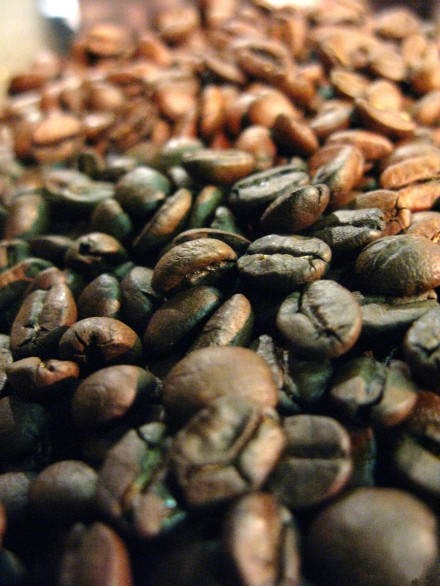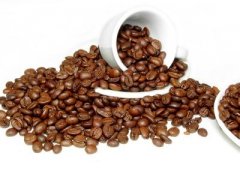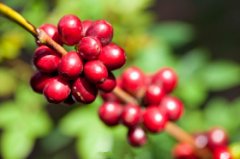Basic concepts of coffee what are the categories of coffee?
Coffee trees can be divided into two main varieties: Arabica (Arabica) and Robusta (Robusta). There are also some minor species, such as the Liberian species (Liberica) and the Alabasta species (Arabusta), but they are rare on the market.

Although Arabica and Roberta are widely cultivated, there are significant differences between them. Beans are different and tree species are not the same. Therefore, their use is also different. The world's production of Arabica beans is about 70%, while Robosta and others account for 30%.
Arabica can produce a rich Krima with an overflowing aroma and a light layer of dark yellow grease floating on the surface. Roberta can produce more Krima, but there is a big bubble and it disappears quickly. Roberta contains twice as much caffeine as Arabica. The caffeine content is 2.2-2.4% and 1.1-1.3% respectively. If too much robusta is added to the Italian concentrate, it will taste like a gelatinous drug.
1. Arabica Coffee Tree (Arabica)
The country of origin is Ethiopia, and its coffee bean production accounts for 70% of the world's output; the world-famous Blue Mountain Garffin, mocha coffee and so on are almost all Arabica species. The oldest coffee tree species, growing in high places, is usually grown in mountains, plateaus or volcanic slopes. The most suitable height for growth is 1000m / 2000m above sea level. The higher the altitude, the better the quality. The annual precipitation in these areas is in 150--5000px, and the day is warm and the night is cool, and the annual average temperature is between 15Mel and 24C °. And its tree species have poor ability to resist diseases and insect pests and are easy to be damaged, and the annual yield of coffee trees per unit area is also low.
During the day, they like mild temperatures and less than two hours of direct sunshine, so if there is a lack of afternoon showers or fog to report every day, local farmers have to plant many taller trees in the coffee garden for shade. At night, they want an environment of about ten degrees Celsius but not too low, because too warm will make the coffee berries grow too fast to produce small, strong, hard and high-quality coffee beans; in case it is too cold to frost, the coffee trees will freeze to death.
Based on these characteristics, the promised land suitable for Arabica coffee growth is mostly located in countries with alpine terrain between the Tropic of Cancer and the Tropic of Cancer, between latitudes of 25 degrees north and south, which is also known as the coffee belt (Coffee Zone/Coffee belt).
Most Arabica baristas in the world get it by "washing" or wet processing. Such coffee beans are generally larger, longer, flatter, oval and zigzag than Robusta coffee beans. And contains less caffeine, can have a lighter and more delicious sour taste.
Of the many variants of Arabica, the most special and famous are Tibica and Porter. Many other varieties have been derived from these two coffee varieties, such as Tikou tico, Kent kent, Mocha mpkka, Blue Mountain Blue mountain, Brazilian hybrid, Ganica garnica and Mibiraz mibirizi, etc. Katuwa is another kind of coffee bean mutant.
Maragogype is the most famous variety of Tibica, and the Malaggippe coffee bean is the largest coffee bean in the world.
Arabica's characteristics: diversity of taste and acidity, high acidity, less caffeine, red color, less grease, can only grow above 800 meters above sea level, strong aroma, and a variety of different flavors, taste more pure, taste lubrication, chocolate, vanilla and nutty flavor. This kind of coffee is used in the best coffee shops in the world, and experts believe that the quality of this kind of coffee depends on the reasonable blending of bean seeds. Brazil is the largest growing country of Arabica beans, followed by Colombia and India.
2. Robsta Coffee Tree
Robusta coffee trees now grow throughout the tropics and are native to Congo in Africa, but most of the world's Robusta comes from western and central Africa, Southeast Asia and Brazil, and they grow from sea level to 700 meters above sea level. The coffee trees planted by Robusta can grow on flat land, have strong adaptability to the external environment, can resist bad weather, resist diseases and insect pests, and do not need much manual care during soil preparation, weeding and pruning, and can be allowed to grow in the wild. It is a kind of coffee tree that is easy to cultivate. But its flavor is more bitter than Arabica, and its quality is much lower, so it is mostly used to make instant coffee. In general, the coffee sold in fast food restaurants mainly uses Robusta coffee beans as the material. Because it is made in Africa, most Africans drink robusta coffee. It has strong resistance to disease and high yield, accounting for less than 30% of the world's total coffee production. Compared with Arabica beans, Robusta beans are more round in appearance, with a slightly inflated side with cracks in the middle, and straight grooves reminiscent of soybeans, while Arabica beans are oval and zigzag, a bit like half a peanut. Generally speaking, Robusta beans have a poor taste, mellow taste, caffeine content is 2 to 3 times that of Arabica beans, and the price is cheap, mostly for the large coffee industry to produce instant coffee or low-cost comprehensive products.
Robusta's florescence is very unconventional, from full flowering to coffee cherry ripening takes 10 murmur11 months. Usually processed by non-washing or drying, this coffee bean is smaller and more wrinkled than Arabica beans.
The most common variants of Robusta species are Conilon conilon, Nana nana and Kangens congensis of Brazil.
Robusta coffee trees have a high annual output per unit area and can be harvested in large quantities by machine. in general, the cost of production is lower than that of Arabica coffee.
Robsta's characteristics: low acidity, high caffeine content, brown color, thick fat, coffee originating from Africa, more extensive nature, high caffeine content, widely used in industry, instant coffee and some traditional coffee shops and supermarkets. Adding Robesta beans to Italian concentration can make Krima more stable and longer, but Krima is not delicate. The compound aroma in Klima keeps the taste and aroma longer, has less flavor than Arabica, and can increase the taste and gelatinous taste of coffee.
Arabica on the left and Robusta on the right
3. Liberian coffee trees
Liberia, which is native to Africa, has a shorter cultivation history than the other two coffee trees, so it is only planted in a few places such as Liberia, Surinam and Gaiana, so it accounts for less than 5% of the world's output. The coffee tree of Liberia is suitable for planting in the lowlands, and the coffee beans produced have a strong aroma and bitter taste.
IV. Insect pests, diseases and natural disasters
Pests: 850 kinds of pest diseases regularly invade coffee countries (ash disease, coffee berry worms).
Diseases: one of the most serious diseases of coffee plants is leaf rust; fungi in the soil cause another disease that is fatal to coffee, microtubule fungal disease, also known as coffee Fusarium wilt, and coffee berry disease, also known as brown Fusarium wilt and red vesicular disease (fungal disease).
Natural disasters: earthquakes, hurricanes, frosts.
Important Notice :
前街咖啡 FrontStreet Coffee has moved to new addredd:
FrontStreet Coffee Address: 315,Donghua East Road,GuangZhou
Tel:020 38364473
- Prev

The basic knowledge of fine coffee
Specialty coffee is also known as specialty coffee. It refers to coffee made from green beans with excellent taste characteristics grown in a few extremely ideal geographical environments. Depending on the particular soil and climatic conditions in which they are grown, they have outstanding flavors. Fine Coffee Drinking Coffee Coffee made from fine coffee beans
- Next

The basic concept of coffee the main ingredients of coffee
1. Caffeine is the most eye-catching of all the ingredients of coffee, with a particularly strong bitter taste. It is a kind of phytoxanthin (animal muscle component). Its properties are the same as theobromine contained in cocoa, green tea contains the same theophylline, the percentage of reduction after baking is very small, and the effect of caffeine is very extensive. it affects the brain, heart, blood vessels, gastrointestinal tract, muscles and kidneys.
Related
- Beginners will see the "Coffee pull flower" guide!
- What is the difference between ice blog purified milk and ordinary milk coffee?
- Why is the Philippines the largest producer of crops in Liberia?
- For coffee extraction, should the fine powder be retained?
- How does extracted espresso fill pressed powder? How much strength does it take to press the powder?
- How to make jasmine cold extract coffee? Is the jasmine + latte good?
- Will this little toy really make the coffee taste better? How does Lily Drip affect coffee extraction?
- Will the action of slapping the filter cup also affect coffee extraction?
- What's the difference between powder-to-water ratio and powder-to-liquid ratio?
- What is the Ethiopian local species? What does it have to do with Heirloom native species?

